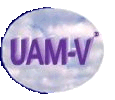
| Home | Information | Software | Memos | Need Help? |
 |
UAM-V® Photochemical Modeling System | ||||||
|
|||||||
|
Q:
How can I submit a question for the FAQ? - - - Q: How can I submit a question for the FAQ? A: You can submit a question for the FAQ by sending it by e-mail to Sharon Douglas of ICF International/SAI at SDouglas@icfi.com, and including in your message that you would like your question added to the FAQ. Q: What exactly is the parameter “mxxx”in parm.cmd? How is it different from “mxx”? A: The parameter “mxxx” is the largest allowed value for either the “x” or “y” dimension in any of the grids, including the fine grids. Thus, it is the largest of mxx, mxy, mxfx, and mxfy, where mxx and mxy are the maximum x and y dimensions allowed in the coarse grid and mxfx and mxfy are the maximum x and y dimensions allowed in any of the fine grids. Q: I have problems running the sample job script. What could be going wrong? A:
The command job uamv.sample.job is designed to run under the c-shell on
a Unix-like system, and should also work under Linux. There are a few
things you must do to prepare to run the file. The job must have execute
rights. You can ensure this by typing cd /a3/common/tcm/release.130/sample/run should be set to change
to the directory where uamv.sample.job is located. ./uamv.sample.job or /bin/csh ./uamv.sample.job Q: What coordinate system does UAM-V® version 1.30 operate in? A: The UAM-V® has two options for the grid system: either a latitude/longitude grid or a Cartesian grid measured in km. Prior versions required that the Cartesian system be based on UTM coordinates. However, the UAM-V® version 1.30 can use a grid system based on an arbitrary rectangular coordinate system (so long as the distances are measured in kilometers). Coordinate conversions from UTM to latitude/longitude used to be built into the UAM-V® code. In v. 1.30 coordinate conversions have been moved from the model to a preprocessor (the terrain preprocessor). The supplied version of this processor includes the UTM conversion. In order to use an alternate coordinate system, an appropriate conversion routine must be supplied. UAM-V® needs the location of each cell center in latitude and longitude coordinates. This location is used for solar radiation calculations. Therefore, the coordinate conversion routines calculate this location from the Cartesian coordinates of the cells. Q: For which compiler is the UAM-V® v. 1.30 Makefile and what do the options mean? A: The UAM-V® v. 1.30 Makefile supplied on the CD works for a Fortran 77 compiler on a DEC Alpha system. It uses the f77 command for compilation; some systems use a different command name for the Fortran compiler. The options are as follows: FCFLGS = -O -static -switch fe_ioworst -convert big_endian -non_shared The -O option is for default optimization, which we recommend for most systems. -static causes all variables to be statically allocated. That is, local variables in subroutines retain their values between calls. This option may have a different name on some systems. This is the default on many systems. -switch fe_ioworst and -convert big_endian are both DEC-specific options that cause the binary i/o to use a byte order that is consistent with most other Unix based workstations. DEC uses a byte order that is reversed from that used on most Unix systems and these options allow files written on DEC to be used on other Unix systems such as Sun or SGI, and vice versa. These options are not available or necessary on systems other than DEC. A comparable option for the Portland Group compiler on Linux is -Mbyteswapio. -non_shared prevents the loader from making a dynamically allocated executable. Therefore, the executable that is produced includes all library routines that are necessary for execution. This makes it easier to run the program on multiple systems of the same brand which may have slightly different locations for system libraries. This option may have a different name on systems other than DEC. Although it is convenient, it is generally not necessary. Q: The error, "The conditional argument must be of type logical" appears when I try to compile. A: This is an omission in the declarations, and has been fixed in our latest version, v1.50. The fix is to add the line logical lmtbe, lnphn, lphch to the comchem.cmd file. On a COMPAQ Alpha system, the variables default to logicals since they are never used as integers and only appear in the context of a logical variable. In general, however, they should be explicitly declared. |
||